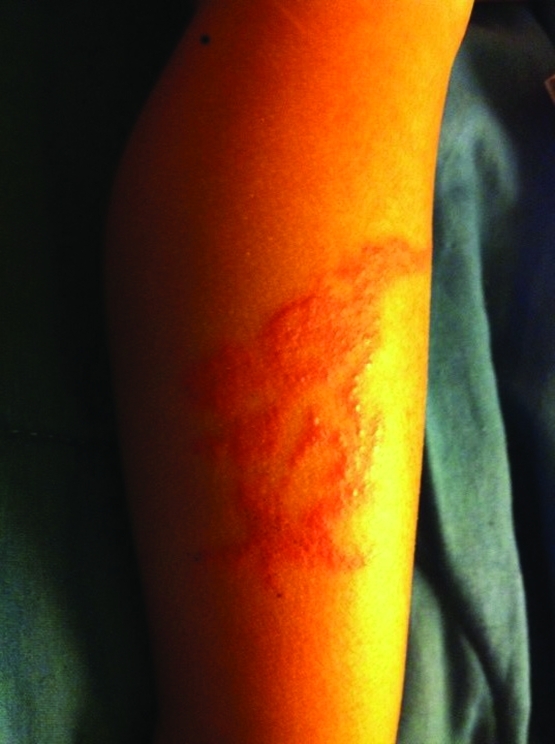The addition of paraphenylenediamine (PPD) into henna dyes and the potential for this allergenic chemical to cause hypersensitivity reactions is a public health issue.1,2 PPD is an oxidative chemical that is used in many home and salon permanent hair coloring products. “Henna tattoo artists” are continuing to add PPD to natural henna in their practices to increase the intensity and longevity of the tattoo and expedite the drying time for the henna.3,4 Many persons believe that the “temporary” status of the tattoos makes them safe. This in fact is not true. There are hundreds of cases ranging from mild eczema to bullous reactions to scarring and permanent hypopigmentation reported, with increasing numbers being reported in younger children. Figures 1 and 2 show a 30-month-old child who received a dolphin tattoo while vacationing in Hawaii and developed a hypersensitivity reaction.
Figure 1.
This is a black henna tattoo on a 30-month-old child.
Figure 2.
The child in Figure 1 developed this hypersensitivity reaction to the balck henna.
These temporary tattoos can cause significant and lifelong sensitization, which would likely lead to reactivity in the future to permanent hair dyes, rubber chemicals, inks, clothing dyes5 and some diabetic and blood pressure medications (sulfonamides and hydrochlorothiazides).6 Furthermore, since sensitization to the chemical is lifelong, hairdressers with this allergy may need to change jobs as they frequently contact this chemical in the workplace.7
In 2003, Health Canada alerted its citizens to avoid “black henna” temporary tattoo ink and paste containing PPD. Section 16 of their Food and Drugs Act prevents the sale of cosmetics that may harm the consumer, including “black henna” temporary tattoos containing PPD, which are often sold and applied by artisans at markets, fairs, and amusement parks.8 As part of the European Community Cosmetics Directive, the European Scientific Committee on Cosmetic Products and Non-food Products has made recommendations on the concentration of PPD along with restrictions and warnings.9 This directive explicitly warns that the use of a temporary black henna tattoo can increase sensitization to PPD and its derivatives. A similar directive has been passed in New Zealand.
With growing reports of sensitization, the American Contact Dermatitis Society (ACDS) awarded PPD the title of “2006 Allergen of the Year” to highlight the allergen and bring public awareness to the emerging patterns of exposure.6 In 2008, the ACDS and the American Academy of Dermatology, as a joint initiative, issued a health advisory warning. Since then, New Jersey introduced legislation to obtain parental consent for minors prior to receiving a black henna tattoo, Oklahoma introduced legislation to license henna tattoo artists, and the Florida Department of Health has a consumer advisory on the use of black henna that states that they will investigate reports of the application of black henna tattoos. Furthermore, the Centers for Disease Control and Prevention (CDC) has listed PPD as an allergen.10
In the majority of U.S. states, there is no regulatory statute on artists who sell the tattoos at holiday resort venues. Furthermore, no national position statement or a minimum proposed age restriction mandate for this practice has been made. This is concerning given that the direct application of the PPD to the skin (in cosmetic products) has been an act prohibited by the FDA since 1938, because it increases the potential for contact sensitization. According to the FDA, the only legal use for PPD in cosmetics is in hair dye.
It stands to reason that this prohibition should be across the board and pertain to the black henna tattoo practice as well. Given the significant number of persons who receive these tattoos on holiday, we hail to the sunshine states to take lead and initiate regulation on the use of PPD that restricts its use to permanent hair dye in cosmetics and restricts exposure, especially to minors. Because the practice of henna tattooing with illicit PPD is so pervasive in the United States, an all out ban of this practice in minors by states would at least protect our vulnerable youth from exposure. Other needed initiatives include public education programs on the dangers of exposure to higher concentrations of PPD. The time is upon us to put into place protective laws placing specific rules regarding the sale or distribution of PPD laden temporary tattoo products and safeguard our children.
Footnotes
DISCLOSURE:The authors report no relevant conflicts of interest.
REFERENCES
- 1.Jacob SE, Zapolanski T, Chayavichitsilp P, Connelly EA, Eichenfield LF. P-phenylenediamine in black henna tattoos—a practice in need of policy in children. Arch Pediatr Adolesc Med. 2008;162(8):790–792. doi: 10.1001/archpedi.162.8.790. [DOI] [PubMed] [Google Scholar]
- 2.Sachdev M. Allergic hypersensitivity reactions to temporary henna tattoo: a newer emerging form of beauty contact dermatitis. J Am Acad Dermatol. 2005;52(3 Suppl 1):76. [Google Scholar]
- 3.Blair J, Brodell RT, Nedorost ST. Dermatitis associated with henna tattoo. Postgrad Med. 2004;116(3):63–65. doi: 10.3810/pgm.2004.09.1590. [DOI] [PubMed] [Google Scholar]
- 4.Sosted G, Johansen JD, Andersen KE. Menné T. Severe allergic hair dye reactions in 8 children. Contact Dermatitis. 2006;54(2):87–91. doi: 10.1111/j.0105-1873.2006.00746.x. [DOI] [PubMed] [Google Scholar]
- 5.Matulich J, Sullivan J. A temporary henna tattoo causing hair and clothing dye allergy. Contact Dermatitis. 2005;53:33–36. doi: 10.1111/j.0105-1873.2005.00626.x. [DOI] [PubMed] [Google Scholar]
- 6.DeLeo VA. Contact allergen of the year: p-Phenylenediamine. Dermatitis. 2006;17(2):53–55. [PubMed] [Google Scholar]
- 7.Lind ML, Boman A, Sollenberg J, Johnsson S, Hagelthorn G, Meding B. Ann Occup Hyg. 2003;49(5):236–240. doi: 10.1093/annhyg/mei030. [DOI] [PubMed] [Google Scholar]
- 8. [May 26, 2011]. http://www.hc-sc.gc.ca/ahc-asc/media/advisories-avis/ 2003/2003_66_e.html
- 9.http://ec.europa.eu/consumers/sectors/cosmetics/documents/ directive/index_en.htm#h2-consolidated-version-of-cosmetics-directive-76/768/eec Accessed May 26, 2011.
- 10.NIOSH International Chemical Safety Card for p-Phenylenediamine (PPD) [May 26, 2011]. http://www.cdc.gov/niosh/ipcsneng/neng0805.html




